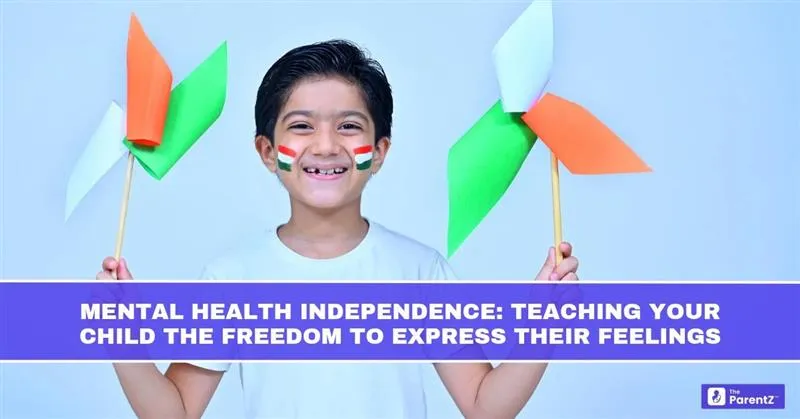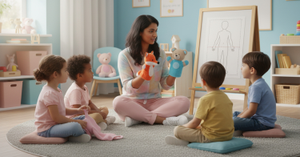In a world where mental health struggles are rising among children and adolescents, one of the most protective things a parent can offer is emotional freedom, the ability to feel, name, and express one’s emotions without fear of judgment or punishment. Mental health independence isn’t just about being strong; it’s about being self-aware, emotionally literate, and safe to express.
Teaching children how to own their emotions, rather than suppress them, builds resilience, prevents mental health crises, and fosters a lifelong ability to cope. This article, backed by pediatric psychology literature and child development research (NHS, RCPCH, CDC), outlines practical ways to help children develop mental health independence.
What is Mental Health Independence?
Mental health independence means that a child:
- Recognizes their own emotions
- Can express feelings in age-appropriate ways
- Feels safe talking about difficult thoughts or situations
- Understands that emotions are valid, even if they are uncomfortable
- Learns basic emotional regulation tools like calming down, asking for help, or setting boundaries
It doesn’t mean being emotionally alone or never needing support. It means building an internal emotional compass—so the child doesn’t rely solely on adults to validate or manage how they feel.
Why Emotional Expression Matters in Childhood
Suppressed emotions in children can manifest as:
- Anxiety
- Behavioural issues
- Somatic symptoms (headaches, stomach aches)
- Academic difficulties
- Poor social relationships
- Sleep disturbances
According to the American Academy of Pediatrics and Royal College of Psychiatrists, early emotional suppression is linked with a higher risk of depression, self-harm, and emotional dysregulation in adolescence.
Giving children permission and tools to express themselves protects them from long-term emotional distress and improves confidence, empathy, and problem-solving.
Developmental Milestones of Emotional Awareness
- Toddlers (1–3 years): Begin to name basic feelings like happy, sad, or angry
- Preschoolers (3–5 years): Can describe situations that trigger emotions
- Primary School Age (6–9 years): Begin to understand complex emotions like embarrassment or guilt
- Tweens and Teens (10–17 years): Start to explore internal states, identity, and peer-related emotions
By tailoring emotional guidance to your child’s stage, you help build a foundation of healthy expression.
How Parents Can Teach Emotional Freedom
1. Model Emotional Honesty
Children learn how to process emotions by watching their caregivers.
Say things like:
- “I’m feeling overwhelmed, so I’m going to take a break.”
- “I’m sad today, and that’s okay.”
Avoid hiding all difficult emotions. Show that even adults need space, support, and time to process.
2. Normalize a Full Range of Emotions
Don’t label emotions as “good” or “bad.” Anger, jealousy, sadness, and frustration are all normal.
Instead of saying:
- “Don’t cry.” → Try: “It’s okay to cry. I’m here.”
- “Stop being angry.” → Try: “I see you’re angry. Do you want to talk or take a break?”
This removes shame and allows the child to sit with their emotions safely.
3. Use Emotion Vocabulary Daily
Help children name what they feel. Emotion charts, feeling flashcards, or books like The Color Monster (for younger kids) or journaling (for older ones) build this emotional vocabulary.
Example:
- “Are you feeling nervous or excited before your test?”
- “It’s okay to feel two things at once.”
Children who can label their emotions are more likely to regulate them effectively.
4. Create Emotionally Safe Spaces at Home
Make it clear that no feeling will get them punished or dismissed. Regular check-ins, bedtime conversations, or “worry boxes” allow children to share feelings without pressure.
Encourage statements like:
- “You can tell me anything, even if it feels scary.”
- “I won’t be upset if you’re upset. I just want to understand.”
This lays the foundation for trust and vulnerability, key aspects of mental health independence.
5. Teach Regulation, Not Repression
Once emotions are named and accepted, guide your child toward healthy coping:
- Deep breathing
- Drawing or journaling
- Going outside
- Talking to someone
- Creating a calm-down corner at home
Avoid telling children to “be brave” or “ignore it.” Instead, equip them to feel and then move through their emotions.
6. Validate First, Advise Later
When your child is upset, lead with validation:
- “That sounds really tough.”
- “I can see you’re hurting.”
Once they feel heard, then gently offer solutions or support. Validation reduces emotional resistance and teaches them their feelings are not a burden.
7. Respect Their Privacy as They Grow
Teens especially need emotional independence. This means:
- Not demanding every detail
- Not reacting with panic when they disclose something difficult
- Offering professional support when needed (counsellors, school psychologists)
Trust them to manage more, but remind them you are always there as a safe landing space.
Cultural Barriers to Emotional Freedom
In many Indian and Asian households, emotional expression, especially among boys, is discouraged. Phrases like:
- “Stop crying, be strong.”
- “What will people say?”
- “You’re too sensitive.”
These can cause children to internalize shame and detach from their emotional truth.
As a parent, breaking these patterns starts with your own emotional healing. Seek therapy, read books on conscious parenting, and create a home culture that says:
“Feelings are human. Emotions are not a weakness. Vulnerability is strength.”
When to Seek Professional Help
Even with support at home, some children need extra help to manage their emotional world.
Red flags that warrant referral:
- Withdrawal from activities
- Self-harm or aggressive behaviour
- Changes in sleep or appetite
- Academic regression
- Constant feelings of worthlessness or hopelessness
Paediatricians, child psychologists, and school counsellors are key partners in nurturing mental health independence when the emotional load becomes too heavy.
Conclusion
Emotional freedom is a gift every child deserves. When we teach children that their feelings are valid, safe, and manageable, we empower them for life. Mental health independence doesn’t happen in silence; it begins with open doors, honest conversations, and caregivers who listen more than they lecture.
In raising emotionally literate children, we don’t just protect them from mental illness; we help them become more resilient, empathic, and self-assured human beings.
References
- NHS – Supporting Your Child’s Mental Health
- American Academy of Pediatrics – Emotional Development in Children
- CDC – Adverse Childhood Experiences and Mental Health
- Royal College of Psychiatrists – Parenting and Mental Health
- Harvard Center on the Developing Child – Serve and Return Interaction








Be the first one to comment on this story.